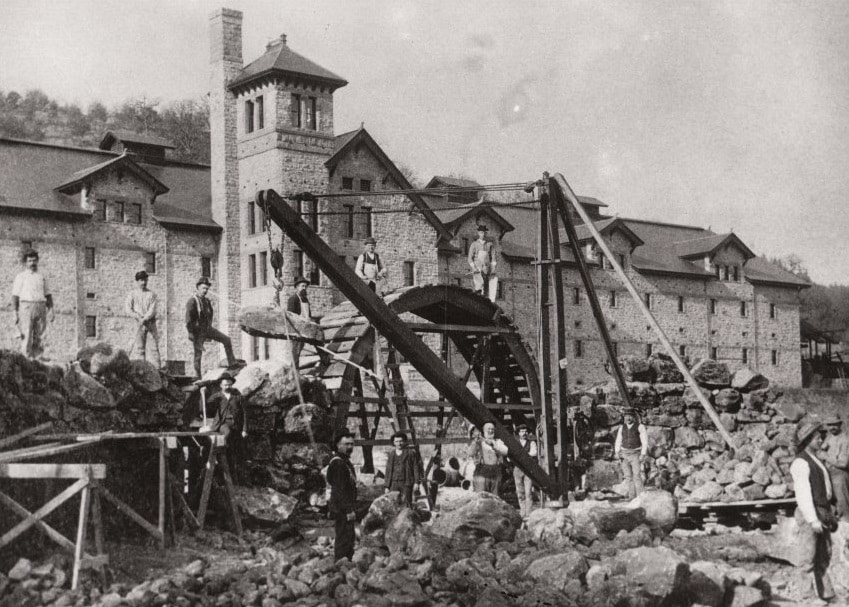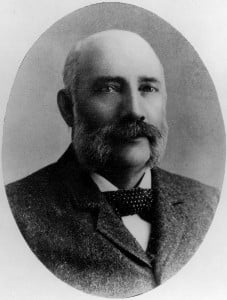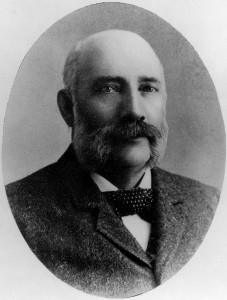People, Wine and Viticulture
Hamden McIntyre

Hamden W. McIntyre, the now legendary Napa Valley winery designer, was born in Randolph, Vermont in 1834. As a young man he apprenticed as a piano and organ maker, and later was the superintendent of lumber company before taking up machinery manufacturing. He formally trained as a civil engineer and draftsman while serving as a volunteer in the civil service. Towards the end of his four years of service, McIntyre joined active duty military and served his last six months in the Civil War. After his discharge from the military, Hamden McIntyre studied chemistry, electricity, and winemaking where he trained under the guidance of French champagne producer Jules Masson. By the late 1860s, he had been recruited by his brother Dr. Hugh McIntyre to work in San Francisco as part of a team of Vermont Yankees chosen by Hugh to manage the re-organization of the newly formed Alaska Commercial Company. Often referred to by his honorary title of “Captain,” Hamden McIntyre served as a successful agent for the Alaska Commercial Company during the 1870s, and soon became friends with Captain Gustave Niebaum, the youngest owner of the company and a former sea captain who had accumulated a great deal of wealth in the fur trade.
In November of 1880 Gustave Niebaum, with the dream of becoming Napa Valley’s finest winemaker, acquired a sizeable amount of acreage in Rutherford. By 1881 Niebaum, who had a great deal of respect and confidence in Hamden McIntyre, offered McIntyre a job as his foreman and general manager at the Inglenook property and to oversee the design and manage the construction of a new winery. McIntyre’s decision to work for Niebaum would later prove to be the beginning of an illustrious, albeit brief, career in Napa and Sonoma counties designing gravity-flow wineries.
The new winery building at Inglenook was no ordinary shed structure. Under Niebaum’s direction, McIntyre designed a winery unlike any other seen in Napa County. In most cases native fieldstone was used, often quarried in the hills above the winery site. His cellar design typically measured about 120 feet in length by 55 feet in width, and became the standard ‘McIntyre’ footprint. Side-gabled roofs constructed of corrugated iron resting on a sub-roof of wood and concrete floors were other innovations used at the time by Hamden McIntyre. The structures are also unique because of the presence of dormers and symmetrically placed windows rectangular in shape with cut stone sills and lintels and segmented arched doorways and corners with cut stone quoins.
According to the St. Helena Star on July 3, 1884, “Capt. McIntyre is discovering a talent for designing cellars that promise to be of great value to our vintners and has already been of advantage on several occasions. He it is [sic] who designed Christian Adamson’s [ed. note – known today as Frog’s Leap] and others and his practical knowledge of the requirements of winemaking, together with his mechanical and artistic skill in representing these ideas on paper, will probably make him, if his time permits, the most valuable assistance in that line that we have ever had…H.W. Mclntyre has demands from all over the State for his ideas and plans for wine cellars. He is considered to be the best authority on the construction of wine cellars.”
 By the mid to late 1880s, McIntyre was in demand all over California, and was considered to be the best authority on the construction of wine cellars in the state. In the late-1880s, Gustave Niebaum arranged a meeting between Hamden McIntyre and railroad magnate Leland Stanford who had a dream of building the largest winery complex in the world. This was a challenge for McIntyre, but one he was willing and eager to undertake. Although the vision was not achieved due to Stanford’s untimely death in in 1893, it was nonetheless a testament to Hamden McIntyre’s integrity and reputation. During this period, Hamden McIntyre was also elected President of the Grape Growers and Wine Makers Association where he took on battles between the Viticultural Commissioners and the State University.
By the mid to late 1880s, McIntyre was in demand all over California, and was considered to be the best authority on the construction of wine cellars in the state. In the late-1880s, Gustave Niebaum arranged a meeting between Hamden McIntyre and railroad magnate Leland Stanford who had a dream of building the largest winery complex in the world. This was a challenge for McIntyre, but one he was willing and eager to undertake. Although the vision was not achieved due to Stanford’s untimely death in in 1893, it was nonetheless a testament to Hamden McIntyre’s integrity and reputation. During this period, Hamden McIntyre was also elected President of the Grape Growers and Wine Makers Association where he took on battles between the Viticultural Commissioners and the State University.
McIntyre had completed the designs for over a dozen wine cellars and his term of service as President the Grape Growers and Wine Makers Association by 1887. What began in Inglenook and lead to McIntyre designed cellars across the Napa Valley that included Greystone Winery (currently the Culinary Institute of America), Trefethen Family Vineyards (formerly Eshcol Winery), Far Niente Winery, Inglenook Winery, Del Dotto Vineyards (formerly Hedgeside Winery), Beaulieu Vineyard (formerly the Ewer & Atkinson Winery), and Chateau Montelena Winery was coming to an end. In the 1890s, Hamden McIntyre and his wife Susan, whom he had married in 1859, returned to his hometown. He participated in several committees in the Vermont State Legislature dedicated to transportation and bridge construction until September 19, 1909, when he died of heart disease on a creek-side path while walking home to lunch.


